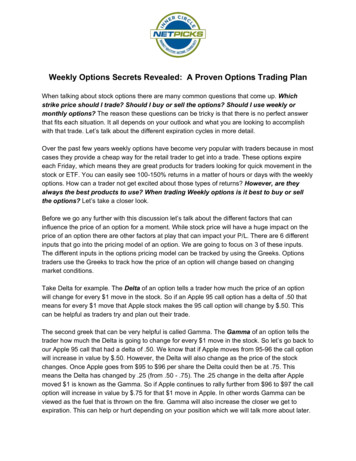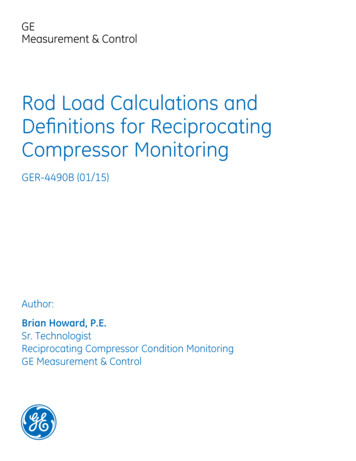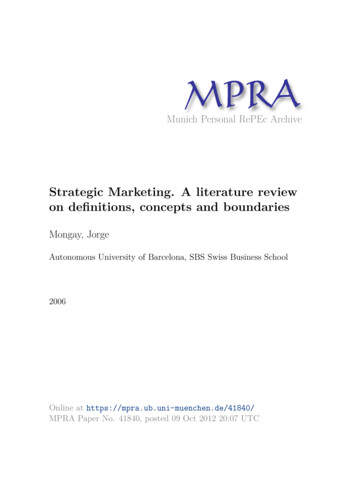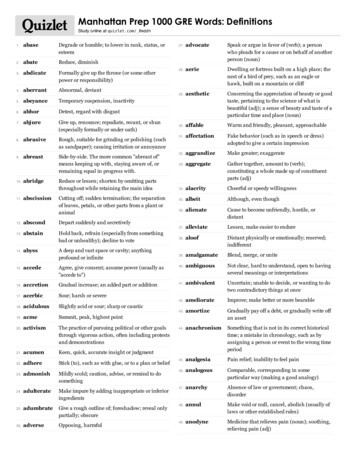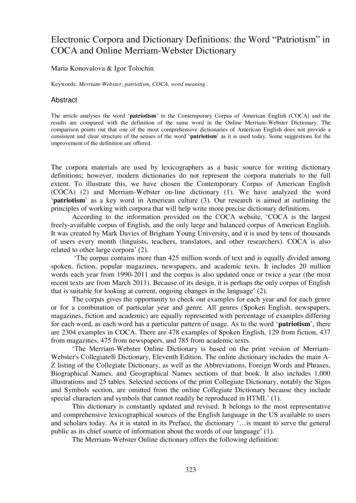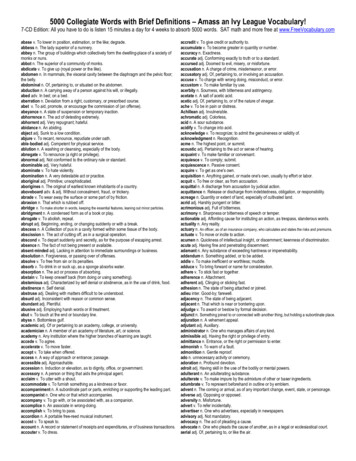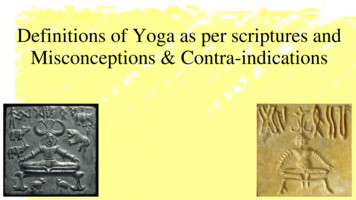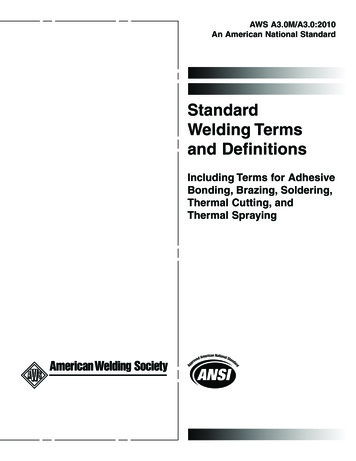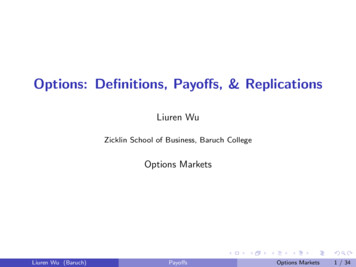
Transcription
Options: Definitions, Payoffs, & ReplicationsLiuren WuZicklin School of Business, Baruch CollegeOptions MarketsLiuren Wu (Baruch)PayoffsOptions Markets1 / 34
Definitions and terminologiesAn option gives the option holder the right/option, but no obligation, to buyor sell a security to the option writer/sellerIIfor a pre-specified price (the strike price, K )at (or up to) a given time in the future (the expiry date )An option has positive value.Comparison: a forward contract has zero value at inception.Option typesIA call option gives the holder the right to buy a security. The payoff is(ST K ) when exercised at maturity.IA put option gives the holder the right to sell a security. The payoff is(K ST ) when exercised at maturity.IAmerican options can be exercised at any time priory to expiry.IEuropean options can only be exercised at the expiry.Liuren Wu (Baruch)PayoffsOptions Markets2 / 34
More terminologiesMoneyness: the strike relative to the spot/forward levelIAn option is said to be in-the-money if the option has positive value ifexercised right now:FFFFIAn option is said to be out-of-the-money when it has zero intrinsicvalue.FFISt K for call options and St K for put options.Sometimes it is also defined in terms of the forward price at the samematurity (in the money forward): Ft K for call and Ft K for putThe option has positive intrinsic value when in the money. Theintrinsic value is (St K ) for call, (K St ) for put.We can also define intrinsic value in terms of forward price.St K for call options and St K for put options.Out-of-the-money forward: Ft K for call and Ft K for put.An option is said to be at-the-money spot (or forward) when the strikeis equal to the spot (or forward).Liuren Wu (Baruch)PayoffsOptions Markets3 / 34
More terminologiesThe value of an option is determined byIIIIIthe current spot (or forward) price (St or Ft ),the strike price K ,the time to maturity τ T t,the option type (Call or put, American or European), andthe dynamics of the underlying security (e.g., how volatile the securityprice is).Out-of-the-money options do not have intrinsic value, but they have timevalue.Time value is determined by time to maturity of the option and thedynamics of the underlying security.Generically, we can decompose the value of each option into twocomponents:option value intrinsic value time value.Liuren Wu (Baruch)PayoffsOptions Markets4 / 34
Assets underlying exchanged-traded optionsStocks (OMON)Stock indicesIndex return variance (new)Exchange rate (XOPT)FuturesLiuren Wu (Baruch)PayoffsOptions Markets5 / 34
Specification of exchange-traded optionsExpiration date (T )Strike price (K )European or AmericanCall or Put (option class)OTC options (such as OTC options on currencies) are quoted differently.Liuren Wu (Baruch)PayoffsOptions Markets6 / 34
Options market makingMost exchanges use market makers to facilitate options trading.A market maker is required to provide bid and ask quotesIwith the bid-ask spread within a maximum limit,Iwith the size no less than a minimum requirement,Iat no less than a certain percentage of time (lower limit)Ion no less than a certain fraction of securities that they cover.The benefit of market making is the bid-ask spread;The risk is market movements.IIThe risk and cost of options market making is relatively large.The bid-ask is wide (stock options). The tick size is 10 cents onoptions with prices higher than 3. It is 5 cents otherwise.Liuren Wu (Baruch)PayoffsOptions Markets7 / 34
Options market makingSince there can be hundreds of options underlying one stock, when the stockprice moves, quotes on the hundreds of options must be updatedsimultaneously.IIQuote message volume is dramatically larger than trade messagevolume.The risk exposure is large compared to the benefit.FFFWhen a customer who has private information on the underlying stock(say, going up), the customer can buy all the call options and sell allthe put options underlying one stock.The market maker’s risk exposure is the sum of all the quote sizes hehonors on each contract.Market makers hedge their risk exposures by buying/selling stocksaccording to their option inventories.IMarket makers nowadays all have automated systems to update theirquotes, and calculate their optimal hedging ratios.IOptions market makers are no longer individual persons, but arewell-capitalized firms.Liuren Wu (Baruch)PayoffsOptions Markets8 / 34
Exchanges that trade stock options in the USA rapidly changing landscapeOld exchanges:IIIICBOE (Chicago Board of Options Exchange)AMEX (American Stock Exchange)PCX( Pacific Stock Exchange)PHLX (Philadelphia Stock Exchange)New developments:IIIISE (International Securities Exchange, May 2000), Deuche Böurse, (2007)BOX (Boston Options Exchange, February 2004)NYSE Arca Options: ((Archipelago PCX) NYSE) Euronext (2007)Liuren Wu (Baruch)PayoffsOptions Markets9 / 34
MarginsMargins are required when options are sold/written.When a naked option is written the margin is the greater of:IA total of 100% of the proceeds of the sale plus 20 % of the underlyingshare price less the amount (if any) by which the option is out of themoneyIA total of 100% of the proceeds of the sale plus 10% of the underlyingshare price.For other trading strategies there are special rulesLiuren Wu (Baruch)PayoffsOptions Markets10 / 34
Payoffs versus P&LsFor European options, the terminal payoff can be written as (ST K ) forcalls and (K ST ) for puts at expiry date T .Since options have positive value, one needs to pay an upfront price (optionprice) to possess an option.The P&L from the option investment is the difference between the terminalpayoff and the initial price you pay to obtain the option.Do not confuse the two.The textbook likes to talk about P&Ls, but I like to talk about payoffs —Different perspectives:IIP&Ls: If I buy/sell an option today, how much money I can makeunder different scenarios? What’s my return?Payoffs: If I desire a certain payoff structure in the future, what typesof options/positions I need to generate it?Liuren Wu (Baruch)PayoffsOptions Markets11 / 34
An example: Call option on a stock indexConsider a European call option on a stock index. The current index level (spotSt ) is 100. The option has a strike (K ) of 90 and a time to maturity (T t) of1 year. The option has a current value (ct ) of 14.Is this option in-the-money or out-of-the-money (wrt to spot)?What’s intrinsic value for this option? What’s its time value?If you hold this option, what’s your terminal payoff?IWhat’s your payoff and P&L if the index level reaches 100, 90, or 80 atthe expiry date T ?If you write this option and have sold it to the exchange, what does yourterminal payoff look like?IWhat’s your payoff and P&L if the index level reaches 100, 90, or 80 atthe expiry date T ?Liuren Wu (Baruch)PayoffsOptions Markets12 / 34
Payoffs and P&Ls from long/short a call option(St 100, K 90, ct 14)303020P&L from long a callPayoff from long a call20100 10 200 10 20708090100Spot at expiry, ST110 306012030302020P&L from short a callPayoff from short a call 306010100 10 20 3060708090100Spot at expiry, ST110120708090100Spot at expiry, ST110120100 10 20708090100Spot at expiry, ST110120 3060 Long a call pays off, (ST K ) , bets on index price going up.Shorting a call bets on index price going down.Liuren Wu (Baruch)PayoffsOptions Markets13 / 34
Another example: Put option on an exchange rateConsider a European put option on the dollar price of pound (GBPUSD). Thecurrent spot exchange rate (St ) is 1.6285 per pound. The option has a strike(K ) of 1.61 and a time to maturity (T t) of 1 year. The 1-year forward price(Ft,T ) is 1.61. The dollar continuously compounding interest rate at 1-yearmaturity (rd )is 5%. The option (pt ) is priced at 0.0489.From the above information, can you infer the continuously compoundinginterest rate at 1-year maturity on pound (rf )?Is this option in-the-money or out-of-the-money wrt to spot? What’s themoneyness in terms of forward?In terms of forward, what’s intrinsic value for this option? What’s its timevalue?If you hold this option, what’s your terminal payoff, if the dollar price ofpound reaches 1.41, 1.61. or 1.81 at the expiry date T ?Liuren Wu (Baruch)PayoffsOptions Markets14 / 34
Another example: Put option on an exchange rateReview the forward pricing formula: Ft,T St e (rd rf )(T t) .rf rd T 1 t ln(Ft,T /St ) .05 ln(1.61/1.6285)/1 6.14%.IRecall covered interest rate parity: Annualized forward return( T 1 t ln(Ft,T /St )) on exchange rates equals interest rate differential(rd rf ) between the two currencies.Long a put option pays off, (K ST ) , and bets on the underlying currency(pound) depreciates.Shorting a put option bets on pound appreciates.How does it differ from betting using forwards?Liuren Wu (Baruch)PayoffsOptions Markets15 / 34
Payoffs and P&Ls from long/short a put option0.50.50.40.40.30.3P&L from long a putPayoff from long a put(St 1.6285, Ft,T 1.61, K 1.61, pt 0.0489)0.20.10 0.1 0.20.10 0.1 0.2 0.3 0.3 0.4 0.4 0.51 0.51.21.41.6Spot at expiry, ST1.8210.50.50.40.40.30.3P&L from short a putPayoff from short a put0.20.20.10 0.1 0.21.821.21.41.6Spot at expiry, ST1.820.10 0.1 0.2 0.3 0.4 0.411.41.6Spot at expiry, ST0.2 0.3 0.51.2 0.51.2Liuren Wu (Baruch)1.41.6Spot at expiry, ST1.82Payoffs1Options Markets16 / 34
1201511510101105510500100 5 595 10 1090 15 15 2080859095100105Spot at expiry, ST110115 208012085859095100105Spot at expiry, ST11011580801202020 801515 851010 905500 5 5 105 10 110 15 15859095100105Spot at expiry, STLiuren Wu (Baruch)110115120 20809095100105Spot at expiry, ST11011512095100105Spot at expiry, ST110115120 100 10 208085 95PayoffPayoffPayoff2015Payoff20PayoffPayoffWhat derivative positions generate the following payoff? 115859095100105Spot at expiry, STPayoffs110115120 120808590Options Markets17 / 34
Put-call conversionsPlot the payoff function of the following combinations of calls/puts and forwardsat the same strike K and maturity T .1Long a call, short a forward.I2Short a call, long a forward.I3Compare the payoff to short a call.Long a call, short a put.I6Compare the payoff to long a call.Short a put, short a forward.I5Compare the payoff to short a put.Long a put, long a forward.I4Compare the payoff to long a put.Compare the payoff to long a forward.Short a call, long a put.ICompare the payoff to short a forward.Liuren Wu (Baruch)PayoffsOptions Markets18 / 34
Put-call conversions: Payoff comparison (K 100)21515151010105550Payoff2000 5 5 5 10 10 10 15 15 2080859095100105Spot at expiry, ST110115 2080120 158590495100105Spot at expiry, ST110115 20801201515151010105550Payoff200 5 5 10 10 10 15 159095100105Spot at expiry, ST110115120 208095100105Spot at expiry, ST1101151201101151200 58590620 208085520PayoffPayoff320PayoffPayoff120 15859095100105Spot at expiry, ST110115120 2080859095100105Spot at expiry, STThe dash and dotted lines are payoffs for the two composition instruments.The solid lines are payoffs of the target.Liuren Wu (Baruch)PayoffsOptions Markets19 / 34
The linkage between put, call, and forwardThe above conversions reveal the following parity condition in payoffs of put,call, and forward at the same strike and maturity:Payoff from a call Payoff from a forward Payoff from a putPayoff from a put Payoff from a forward Payoff from a callPayoff from a call Payoff from a put Payoff from a forwardIf the payoff is the same, the present value should be the same — put-callparity:ct pt e r (T t) (Ft,T K ).At a fixed strike (K ) and maturity T , we only need to know the two pricesof the following three: (ct , pt , Ft,T ).One of the three contracts is redundant.Liuren Wu (Baruch)PayoffsOptions Markets20 / 34
Intrinsic values and time values, RevisitedA more formal definition:ct e r (T t) (Ft,T K ) TVt ,pt e r (T t) (K Ft,T ) TVt .Call and put at the same maturity & strike (T , K ) have the same time.Most option pricing models only deal with the time value, and take theforward (financing) and hence intrinsic value as given (starting point).To estimate these option pricing models, one only needs to use the timevalue at each (T , K ), which is the out-of-the-money option (call whenFt K and put otherwise).INormally, the out-of-the-money option is more actively traded, possiblyfor the same reason.— Most professional options traders are trading the time value only.Liuren Wu (Baruch)PayoffsOptions Markets21 / 34
Review: Create forward using spot and bondIn the absence of forward, use spot and bond:Can you use a spot and bond to replicate a forward payoff?What’s the payoff function of a zero bond?Liuren Wu (Baruch)PayoffsOptions Markets22 / 34
Popular payoff I: Bull spread201510Payoff50 5 10 15 2080859095100105Spot at expiry, ST110115120Can you generate the above payoff structure (solid blue line)using (in addition to cash/bond):two callstwo putsa call, a put, and a stock/forwardWho wants this type of payoff structure?Liuren Wu (Baruch)PayoffsOptions Markets23 / 34
Generating a bull spreadTwo calls: Long call at K1 90, short call at K2 110, short a bondwith 10 par.Two puts: Long a put at K1 90, short put at K2 110, long a bondwith 10 par.30202025151520101551005 10 5 15 10 20 15 25859095100105Spot at expiry, STLiuren Wu (Baruch)1101151205 50 208010PayoffPayoffPayoffA call, a put, and a stock/forward: Long a put at K1 90, short a call atK2 110, long a forward at K 100 (or long a stock, short a bond at 100 par). 30800 5 10 15 20859095100105Spot at expiry, STPayoffs110115120 2580859095100105Spot at expiry, ST110115120Options Markets24 / 34
Pointers in replicating payoffsEach kinky point corresponds to a strike price of an option contract.Given put-call party, you can use either a call or a put at each strike point.Use bonds for parallel shifts.A g
Out-of-the-money options do not have intrinsic value, but they havetime value. Time value is determined by time to maturity of the option and the dynamics of the underlying security. Generically, we can decompose the value of each option into two components: option value intrinsic value timevalue. Liuren Wu (Baruch) Payo s Options Markets 4 / 34
